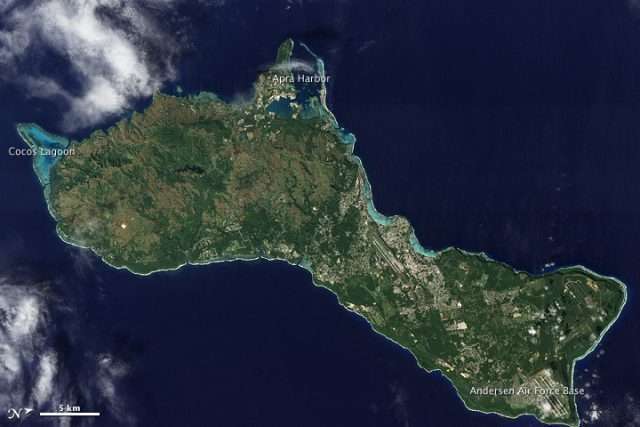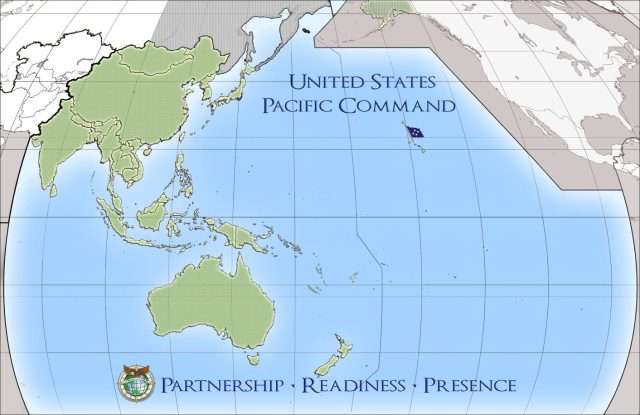The geostrategic importance of the Island of Guam in the U.S. policy of containment of Chinese expansionism in the Asia-Pacific.

Geopolitical Report 2785-2598 Volume 14 Issue 1
Author: Riccardo Rossi
The Island of Guam in the Asia-Pacific region plays a decisive role for the U.S. military and geopolitical strategy in countering Chinese expansion and influence in the area.
The election in 2009 of Barack Obama to the Presidency of the United States represented for the U.S. foreign policy and the Pentagon the overcoming of the ‘Bush doctrine’, in favour of a new geopolitical vision identifiable in the project of Pivot to Asia, which in consideration of the rapid rise of China in the Asia-Pacific region, identified as a priority a shift of American political attention from the Middle East to the Pacific Ocean.
This geopolitical vision introduced by Obama, conceived to contain the economic-military assertiveness of Peking in the Asia-Pacific area, has required the Pentagon, in agreement with the White House, to re-evaluate the geostrategic role of its overseas possessions, such as the State of Hawaii and the Island of Guam, due to their proximity to the geo-maritime areas under dispute with the People’s Republic of China (PRC), included in the East and South China Seas.
Based on these considerations, the objective of this analysis is to understand the geostrategic reasons that led the United States to increase and develop its military assets on the Island of Guam and then to evaluate how these decisions have affected the definition of the subsequent military strategies for the Asia-Pacific region.
The geostrategic importance of the island of Guam in the U.S. policy of Chinese containment in the Asia-Pacific
During Barack Obama’s two terms as President (2009-2017), the United States has progressively rebalanced its political-military interests towards the Asia-Pacific space from the Middle East region.
The Obama Presidency argued the main reasons at the basis of this decision in its first National Security Strategy published in 2010, exposing a project of foreign policy antithetical to the ‘Bush Doctrine’, elaborated by the homonymous Presidency following the attack on the Twin Towers, leading the United States to focus most of its political and military attention on the Middle East region in order to conduct the war on terror against terrorist organizations of Islamic origin, such as Al-Qāʿida in Afghanistan and Saddam Hussein’s rogue state.
The Obama Presidency’s modification of the political-strategic priorities identified by the previous Bush administration can be summed up in two main observations. The first takes note of the unsuccessful U.S. military action in the Middle East, which had generated an anti-Western aversion among the Muslim civilization. To this is added the inability of the Bush presidency to grasp the increase in the geostrategic centrality of the Asia-Pacific area for U.S. interests in the light of the rapid political-military rise of the People’s Republic of China (PRC).
The Obama presidency’s definition of the centrality of the Asia-Pacific region for U.S. political-military interests has led the White House, with the successive administrations of Trump and now Biden, to develop a specific foreign policy program for this region called Pivot to Asia, to counter the growing expansion of the People’s Republic of China within the geo-maritime space between the Asian coastline and the first island chain (Geostrategy and military competition in the Pacific).
In the strategic-military field, the pursuit of this aim has required the Pentagon to develop a doctrine that envisages strengthening of its presence in the Pacific, while at the same time reducing the number of men and means deployed at the bases located in the Middle East, particularly in Iraq and Afghanistan (Washington signed a deal with the Taliban, but this is not the end of the war).
The effects of this decision are observable with the troop withdrawal program from Afghanistan ending in August 2021 and the implementation of a progressive consolidation of both U.S. Army, Navy and Airforce bases located in Japan, South Korea, the Philippines and those located in its overseas territories such as the Hawaiian archipelago and the island of Guam.
In the latter case, the Pentagon’s decision to increase the number of its assets located in Hawaii and Guam is primarily due to their respective geographical locations.
In the case of Hawaii, in observance of its vast extension and proximity to the eastern coast of the United States, the archipelago has been identified by Washington as an essential hub because it is the seat of the United States Pacific Command (PACOM), which is a stronghold for logistical support to naval units and areas operating in the Pacific Ocean.

In the case of the Island of Guam, the main reason that prompted the Obama Presidency to attribute it high geostrategic importance is identifiable in its intermediate position between the first island chain and its relative proximity to Honolulu (4,000 km), Beijing (6,000 km), Manila (2,600 km), Tokyo (2,605 km) and North Korea (2,700 km).
For the United States, this particular location of Guam since its conquest at the end of the Spanish-American War in 1898 has represented a critical island space in the centre of the Pacific Ocean. However, its tactical-strategic usefulness was first enhanced by Admiral Chester Nimitz, commander of the Pacific Fleet, after its reconquest in 1944 following three years of Japanese occupation. Nimitz’s idea to maximize the geostrategic value of the island was to build a headquarters to serve as a repair base for damaged aircraft and ships and a starting point to launch combat missions against Japanese outposts.
With the election of Obama to the White House, the United States reconsidered the idea of Nimitz, in this case, intending to counter the growing military presence of the People’s Republic of China (PRC) in the vicinity of the main sea straits of the China Sea, such as Taiwan, Miyako, Luzon and Malacca.
In this sense, the Pentagon has begun a program to reinforce the two major military outposts on Guam, Naval Base Guam and Andersen Air Force Base, by relocating part of the PACOM forces to the island to respond to two operational needs.
The first envisaged that Guam should link bases located in Japan, South Korea, and the Philippines. To this was added the idea that the island should represent an essential point for launching air-sea operations against the military installations of the Chinese People Liberation Army and People Liberation Navy located between the archipelagos of Spratly, Paracelsus the Chinese coastline.
This decision by the Pentagon to use Guam as an outpost to respond to the two operational needs considered above has made the island a target of primary importance for Beijing, which in the event of conflict could strike it using cruise missiles launched from bombers, ships or SSBN Jin-class.
This eventuality generated an immediate response from the Pentagon by ordering the deployment of the Thermal High Altitude Air Defense (THAAD) missile defence system on Guam, followed by request from Admiral Davidson to install Aegis Mark 41 vertical launch missile batteries (VLS), which unlike the THAAD system are capable of intercepting ballistic missiles like the DF-26 (called Guam Killer) in their intermediate flight phase.
Conclusions
With the election of Obama to the Presidency of the United States and the consequent affirmation of the policy of strategic rebalancing of U.S. interests from the Middle East towards the Asia-Pacific called Pivot to Asia, the Island of Guam has been reconsidered by Washington as the central hub for the implementation of the Chinese containment strategy, primarily concentrated in the archipelagos of the Spratly and Paracelsus islands and the vicinity of the Taiwan, Miyako, Luzon, Malacca and Sunda straits.
This tactical-strategic re-evaluation of Guam, adopted by the Obama administration, has favoured a strengthening of the PACOM command based in Hawaii and, at the same time, an increase in military resources at the two bases in Guam: Naval Base Guam and Andersen Air Force Base.
The objective of this intervention was designed to respond to two operational needs: to support U.S. outposts located in South Korea, Japan and the Philippines, and to use the island of Guam as a staging area for power projection operations aimed at targeting Chinese PLA and PLN military installations located along the coastline and in the Spratly and Paracelsus archipelagos.
Having identified this complex geostrategic framework, it is possible to speculate that in the years ahead for the United States, Guam will represent an increasingly important cornerstone for implementing China’s military strategy in the Asia-Pacific.
An example in support of this hypothesis can be considered the increase of Sino-U.S. tensions regarding the Taiwan issue and the relative project of Beijing to impose its sea control localized in the waters adjacent to Taipei to implement a possible operation of the amphibious invasion of the island (Il confronto militare sino-statunitense per il controllo dell’isola di Taiwan; Chinese militarisation of the South China Sea: a geostrategic necessity?).
Because of this situation, Guam represents for the United States, by virtue of its location and deployment of SSN nuclear attack submarines, SSBN ballistic missile launchers, F-22 jets and B1 and B2 strategic bombers, a vital resource for both the protection of Taiwan’s territorial integrity and the maintenance of a geopolitical balance in their favour in the Asia-Pacific region.
